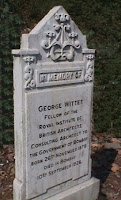 |
| Scottish architect George Wittet artdecomumbai.com |
The Indian cities like Calcutta, Mumbai, Chennai and other cities are dotted with innumerable colonial buildings built during the Raj and under the EIC. Despite their age and passage of time, they all stand apart in the cityscape as unique colonial structures of beauty, splendor and imagination. They served as the offices of the colonial administrators in the past during their heyday and they bear testimony to the ingenious design and talents of the British designers who wanted the buildings to be distinctive in style glorifying the power of British Empire and hegemony in this part of the world.
Among the British architects who worked in the Indian subcontinent George Wittet (1878-1926; born in Blair Atholl, Scotland in 1878) may be a late entrant but was responsible for some of the best colonial buildings in Mumbai (Bombay). George Wittet studied architecture in Perth, Scotland, and in 1904 he became assistant to John Begg, consulting architect to the Government of Bombay. Having worked in Edinburgh and later with Walter Henry Brierley of York, George's rich and varied design experience stood him in good stead. Both he and Begg were responsible for pioneering the Indo-Saracenic style (then quite popular in Madras Presidency government buildings), in designing several government and public buildings across Bombay. Blending of Indo-Islamic elements, with Gothic and neo-classical elements popular in Britain at that time was deliberate. The Raj after came out of the worst revolt in 1857 had to convince the natives and their keen interest in Indian culture and ethos. So, Indo-Saracenic design was looked upon by the natives as Raj’s efforts to promote “ native Indian” culture, so that their colonial subjects would view them more favorably and abide trust in them.
As for Wittet, he didn’t always design the buildings in the Indo-Saracenic style, but gave it good impetus and championed it often enough.
 |
| Gateway of India, Mumbai. i.pinimg.com |
 |
| CSMVS- formerly Prince of Wales Museum,holiday.in |
With a view to assimilating exotic local architectural elements, Wittet went on a study trip in the south -what is now part of Karnataka and was keen to adopt Indo-Saracenic style - a blend of Indo-European style popularized by British architect Robert Chisholm (his inspiration was from Kerala). The gateway of India (archway in Apollo Bunder) and the Prince of Wales Museum (now called CSMVS), Mumbai were built in Indo -Saracenic style and are believed to be among the most identifiable landmarks of Mumbai. His design style took a departure to his favorite style - " classical and Renaissance'' manner as at the Institute of Science (completed 1916).
His other buildings the Institute of Science, the Small Causes Court at Dhobitalao, the Wadia Maternity Hospital, the King Edward Memorial Hospital, Cowasji Jehangir Hall Bombay House. the Grand Hotel and other buildings at the Ballard Estate, by the Bombay Docks bear testimony to his popularity and his prolific design styles pregnant with attractive decorative features.
 |
| Sir JJ College of Architecture, Mumbai |
It was George Wittet who designed the popular building - Bombay House, a four-story colonial structure in which Malad stones were widely used to give it a special look.
 |
| Scottish architect George Wittet, Bombay mid-day.com |
No doubt Wittet, while was a consultant to the Government of Bombay, was unanimously elected as the ''first President'' of the Indian Institute of Architects, and continued the covetous post till 1920. The institute included past students of Architecture of the renowned Sir J.J. School of Art (first institute of architecture in Asia), then called “The Architectural Students Association” in 1917. First courses in architecture started in 1908; a separate department came into being in 1913 headed by Robert Cable. During his long stint in Bombay, he was associated with 95 government projects - mainly their design In addition he successfully completed 44 projects for the famous TATA company.
 |
| Sewri Christian Cemetery, Mumbai whatshot.in |
 |
| Tomb of Architect George Witte, Mumbai findagrave.com |
Above image: Tomb of Scottish Architect George Wittet
Birth: 26 Nov 1878; Blair Atholl, Perth and Kinross, Scotland
Death: 10 Sep 1926 (aged 47),Mumbai (Bombay), Maharashtra, India
Burial: Sewri Christian Cemetery, Mumbai (Bombay), Maharashtra, India/ Memorial ID 92644846 · View Source....................
A prolific architect whose talents were not fully exploited by the govt for various unknown reasons died very young at the age of 48 at Bombay; cause: Dysentery. The famous buildings in Mumbai designed by him stand as everlasting colonial monuments and bear his genius.
https://indianexpress.com/article/explained/george-wittet-architecture-mumbai-7702184/
https://indiaheritagesites.wordpress.com/2013/08/19/reviewing-the-history-of-the-gateway-of-india/









